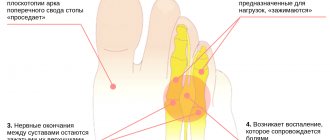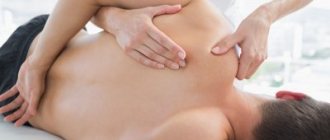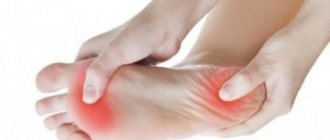Author: Vereskun E. A. Expert: Trubnikov V. I.
2155
Most often, this condition is a characteristic complication of lumbosacral osteochondrosis. If you are worried about lumbago and sciatica, then sooner or later you will encounter neuralgia of the foot.
Metatarsalgia of the foot is a symptom complex indicating certain diseases of the autonomic nervous system and musculoskeletal system. The pain is localized in the metatarsal bones and ankle joint. Overexertion or dystonia of the longitudinal inner arch of the foot may occur. Depending on the manifestations, this pathology may indicate either neuropathy or organic lesions of bone, cartilage, ligament and tendon tissue.
In this article we will talk about the symptoms and treatment of metatarsalgia of the foot, and the potential causes of its occurrence. We will give advice on choosing a specialist who will make an accurate diagnosis and provide effective treatment. All information about the symptoms and treatment of neuralgia of the foot is for informational purposes only. Please treat this responsibly. You should not diagnose and treat yourself. Visit an experienced neurologist. He will tell you how to carry out the examination and treatment. Self-diagnosis and treatment can lead to disastrous consequences.
We strongly recommend that you find a manual therapy clinic near your place of residence. Make an appointment with a neurologist or orthopedist. These specialists have a sufficient level of professional competence to provide you with the full scope of necessary medical care.
Provoking factors
Morton's neuroma develops under the influence of certain external and internal factors. Among the most common reasons are the following:
- Overweight . This reason is the most common, since excess pressure is constantly placed on the lower extremities and nerves are regularly compressed, which leads to the development of Morton's neuralgia.
- Injuries and bruises of various types.
- Infectious diseases that have become chronic are also negatively reflected .
- Flat feet . Many people mistakenly believe that this pathology does not entail serious consequences, but it is the initial stage of many serious diseases. Morton's disease is one of them.
- Regularly wearing shoes with long heels . This in turn leads to bone deformation. Nerve inflammation is one of the consequences.
- Tight shoes . When it is constantly worn, compression of the nerve fibers occurs. This may be accompanied by constant pain and neuralgia.
- Foot tumor.
- Leg overload . When standing for a long time, the feet experience unnatural overloads, which lead to many different diseases.
High heels and uncomfortable shoes are a direct path to plantar neuralgia
Causes
Foot injuries are a common cause of pain. Diseases of the musculoskeletal system and a predisposition to swelling of the legs worsen the situation. In addition to this, the following diseases and conditions of the body cause neuralgia:
- stressful situations;
- joint diseases;
- dysfunction of blood vessels;
- damage to bones, muscles, ligaments;
- alcohol intoxication;
- hypothermia of the body;
- consequences of injections into the spine;
- pinched sciatic nerve;
- increased load on the legs;
- gout;
- age-related changes;
- intervertebral hernia;
- presence of tumors;
- complication resulting from infectious diseases.
Pinching of the sciatic nerve often leads to neuralgia. Infringement can be caused by a herniated disc, which can compress nerve endings.
The process is not uncommon during pregnancy, when an enlarged uterus begins to put pressure on neighboring organs.
Characteristic manifestations
The first stages of the disease are rarely accompanied by significant changes in health status. Unpleasant sensations become noticeable after a few weeks. After the onset of the disease, unpleasant sensations appear when the interdigital area is compressed.
Morton's neuroma is characterized by the following symptoms:
- sharp pain and itching between the fourth and third fingers;
- mild tingling in the toes;
- insurmountable discomfort when walking and running;
- weakening of sensitivity in the area of the fourth and third fingers;
- numbness and swelling of the entire foot;
- sharp pain extending to the fingers or feet.
The described symptoms may subside over time and appear only after a few years. The disease may be dormant, but this does not mean that it has disappeared completely.
Sharp pain occurs only when using long heels. If you wear flat-soled shoes, the pain will immediately subside.
The longer treatment is delayed, the more intense the symptoms. If treatment is delayed too much, the pain will persist, regardless of the shoes used.
Leg pain neuralgia treatment
Neuralgia is a pathological condition caused by damage to certain parts of the peripheral nerves.
Neuralgia is characterized by severe and acute pain along the nerve and in the area of its influence. Many people experience neuralgia at any time in their lives, but most often the pathology develops in women over 40 years of age.
Everything in our body is interconnected.
Peripheral nerves contain certain receptors that receive information about the state of body tissues and transmit it to the brain and spinal cord, and also transmit information from the central formations of the nervous system back to tissues and organs. If any part of the fiber is damaged, the information becomes distorted and a painful reaction occurs as a result.
Causes of neuralgia
It is difficult to say what causes neuralgia. There are many factors that affect nerve fibers, so the causes of neuralgia are varied:
- injuries;
- diseases of the spine;
- posture disorders;
- allergy;
- diabetes;
- diseases of the nervous system;
- infections;
- muscle damage;
- violation of vitamin metabolism, especially B vitamins;
- changes in blood circulation and diseases of the cardiovascular system;
- toxins (mostly the effects of alcohol and drugs);
- introduction of medications into the thickness of the nerve during injection.
The type of neuralgia that occurs is influenced by the location of the lesion, as well as the type of nerve affected. There are neuralgia of the spinal nerves and cranial nerves.
Neuralgia is a disease characterized by pinching of peripheral nerves. With this disease, a person begins to experience severe pain, which sometimes even the most powerful anabolic steroids cannot cope with.
The pathology most often manifests itself after the age of 35; women are much more susceptible to it than men. When the first symptoms of neuralgia appear in adults, it is necessary to urgently sign up for a medical examination, this is the only way to avoid health complications.
This disease is considered quite dangerous because it damages the nerve endings. This disease can damage the nerve in absolutely any part of the body, even in canals and narrow openings.
The patient will periodically suffer from sharp, burning pain in the area of innervation of the affected nerve. Loss of sensation or deterioration in motor activity is usually not observed.
This disease is classified into several forms and subtypes; doctors distinguish between neuralgia of the cranial, femoral and spinal nerves.
Forms of neuralgia
This disease comes in only two forms:
- Primary. Pain response of a specific nerve, unrelated to any specific stimuli. In most cases, it is never possible to identify its original source (discomfort can be caused by stress, the release of adrenaline into the blood, or the presence of certain diseases). This pathology can be cured with an integrated approach; treatment should be aimed at suppressing painful sensations. The most common type is triangular neuralgia;
- Secondary. It is provoked by third-party pathologies, for example, aneurysms, inflammation or tumors. Treatment of this form is more difficult; first of all, the patient will need to get rid of the original source, and only then from the painful sensations. Secondary neuralgia is very dangerous, since in about half of cases it is a symptom of more serious diseases.
The signs of this disease may differ slightly from each other depending on what type of pathology the person is faced with. But the main symptom of neuralgia is cutting pain, which can cause a burning sensation or lumbago.
Painful sensations usually affect not only the nerve itself, but also spread throughout the entire area that it can affect.
If a certain nerve is damaged, a person may experience pain:
- Teeth, left or right side of the face, eyes. Painful sensations in these areas appear with ternary neuralgia. The patient may also experience involuntary salivation and increased tearing of the eyes. If the injured nerve is located close to the surface of the skin, touching this area will provoke new attacks of pain;
- Back of the neck and back of the head. Such disorders occur with occipital neuralgia; in most cases, patients complain of shooting pain;
- Discomfort and tingling in the chest, increasing with inhalation and movement, indicate interfemoral neuralgia;
- Back leg. Pain in this area is a sign of sciatic neuralgia. Because it is very large and has many branches, the burning sensation can be very strong and the pain will spread to most of the leg.
Another sure sign of neuralgia is increased sweating and redness of the epidermis in the area of the affected nerve.
This problem is very common and does not affect about 70% of women carrying a child. The main characteristic of this pathology is compression or irritation of the intercostal nerve.
The disease usually develops due to weakening of the protective properties of the body and accelerated growth of the uterus and fetus, which, when expanded, can put pressure on the ribs. Pain in this case most often occurs in the chest area, in most cases it is aching or pulling.
Signs of anemia during pregnancy:
- painful sensations will mainly occur after physical exertion, a burning sensation may radiate to the back, lower back or shoulder blades;
- a woman will periodically suffer from muscle cramps, and sometimes they can be very painful;
- the appearance of anemia;
- increased sweating;
- change in skin tone in the affected area. The epidermis may turn red or become almost porcelain.
If such symptoms occur, a pregnant woman should make an appointment with a specialist as soon as possible, who will rule out the possibility of heart problems and prescribe appropriate treatment.
Source: https://neuro-orto.ru/bolezni/perifericheskaya-nervnaya-sistema/nevralgyya/nevralgiya-nog.html
Establishing diagnosis
Diagnostic procedures are prescribed by a doctor if the patient presents with relevant complaints.
The doctor examines the patient and interviews him. In the process of collecting an anamnesis, it becomes clear what type of shoes the patient or patient prefers to wear, with what frequency the load is placed on the legs, whether there have been inflammations of the extremities before, and information about all kinds of injuries and bruises is clarified.
After analyzing the survey results, the attending physician prescribes the necessary procedures.
To verify the correctness of the established diagnosis, a medical professional examines the feet. It involves a detailed examination of places where pain reaches a critical level.
If the doctor is not convinced of the presence of neuralgia, then he prescribes magnetic resonance imaging or x-rays.
Anesthesia is used to detect the source of the disease. It freezes the foot, but maintains tactile perception in the affected areas.
The main problem is the difficulty of diagnosing Morton's neuroma, since the main symptoms are similar to other foot diseases.
Preventive measures
Recommended preventive measures:
- wearing comfortable shoes;
- prevention of flat feet;
- using relaxing foot baths;
- regular foot massage;
- body weight control.
You should avoid these heels
Following these tips will help you avoid painful treatment and a long recovery period.
Complex of medical procedures
There are two different approaches to treating plantar fibrosis. The choice of method depends on the neglect and complexity of a particular case.
Conservative treatment
The main point is the refusal of surgical intervention.
First of all, it is planned to significantly reduce the load on the feet and make their work easier. This approach is appropriate at the initial stages of the disease. If the help of a competent specialist was not received on time, then surgery becomes the only and mandatory way to solve the problem.
If the operation is impossible or undesirable for a number of reasons, then it is recommended to resort to conservative methods, which include the following set of procedures:
- use of comfortable shoes with soles without heels;
- wearing specialized orthopedic insoles;
- the use of devices that separate the fingers, which will eliminate the possibility of deformation of the fingers and foot as a whole;
- eliminating stress on the feet, so it is necessary to minimize the time spent in a standing position;
- It is recommended to use orthopedic shoes that correct the surface of the foot in accordance with individual characteristics;
- regular foot massage.
If you use this complex, the pain syndrome will disappear in a few months. Often conservative methods do not have the desired effect and the pain becomes more intense. In this case, it is advisable to use painkillers.
The following drugs are used to suppress pain:
- Codelac;
- Terpincode;
- Nimesulide;
- Solpadeine;
- Diclofenac.
Among the advantages of a conservative approach to the treatment of Morton's neuroma, it is worth highlighting:
- no recovery period;
- painful sensations that are typical in the postoperative period are excluded;
- treatment is carried out without disturbing the usual schedule, there is no need to change the existing rhythm of life, since there is no need to regularly visit the attending physician.
Among the disadvantages it is worth noting the following:
- duration of treatment;
- this method requires large financial investments in comparison with surgical ones;
- side effects from the use of various medications are possible, the functioning of the digestive tract and cardiovascular system is disrupted;
- the most important disadvantage is that there is no guarantee that the therapy will be successful.
Surgical approach
The operation is performed if conservative measures do not bring the desired result.
Three intervention techniques are used:
- normal removal;
- artificially performed bone fracture;
- removal of the inflamed area of the nerve and part of the muscle.
Among the advantages of prompt resolution, the following should be noted:
Place of incisions after surgery
- low cash costs;
- efficiency;
Flaws:
- long recovery;
- At first there will be discomfort while walking.
If treatment is not started in a timely manner, the pain may intensify and the inflammation may spread even further. In the final stages, surgery is a mandatory aspect of treatment.
Symptoms of plantar nerve damage
The disease manifests itself as a sharp shooting pain in the area of the sole (90%), radiating to the 3rd interdigital space.
In 50% of cases, patients are bothered by aching, paroxysmal pain in the sole area. At the beginning of the disease, pain in the sole area appears when walking, then occurs spontaneously at night. Impaired walking due to pain is observed in 50% of patients. Numbness of the tips of the toes, burning, tingling in the sole area - in 60%. Symptoms of the disease may increase or decrease over several years and are aggravated by wearing tight shoes. An objective examination of the patient reveals pain on the sole of the foot in the area of the 3rd interdigital space at the base of the III and IV fingers (90%), hypoesthesia of the fingertips in the zone of innervation of the plantar nerve, paresthesia in the foot (60%). A characteristic click is noted with simultaneous pressure on the interdigital spaces, and increased pain when squeezing the foot in the transverse direction.
How to relieve a migraine attack
Signs of occipital neuralgia indicate the appearance of extensive inflammation. The main symptom is pain localized in the back of the head. With neuralgia, the pathological process involves the meninges, cervical spine, muscles and skin. Often, adult patients experience paroxysms that last a long time.
In older people, damage to the trigeminal nerve occurs due to caries, sinusitis, tumor of the cranial fossa, and herpetic infection. The manifestation of neuralgia is a sudden onset attack, for example, after touching the skin of the face or blowing wind. If pain radiates to the ear, inflammation of the glossopharyngeal nerve is suspected.
Treatment of neuralgia, accompanied by the appearance of a “cluster” headache, involves influencing the cause of the disease. For therapy, the doctor suggests the medicine Mexiletine, which eliminates discomfort and has an analgesic effect. This type of neuralgia can be cured using the following medications:
What is Morton's neuroma?
In Morton's neuroma, the nerve sac between the third and fourth joints of the toes becomes inflamed.
As a rule, neuroma is a consequence of advanced transverse flatfoot. The fact is that a healthy foot rests on the heads of the 1st and 5th joints of the toes. With transverse flatfoot, the transverse arch of the foot loses its arch shape, and the entire load is transferred to the joints of the 3rd and 4th toes. The foot “spreads” and the nerve endings remain pinched at the tops of the joints. Inflammation begins.
Elena Malysheva talks about what Morton's neuroma is in the program “Live Healthy!”











